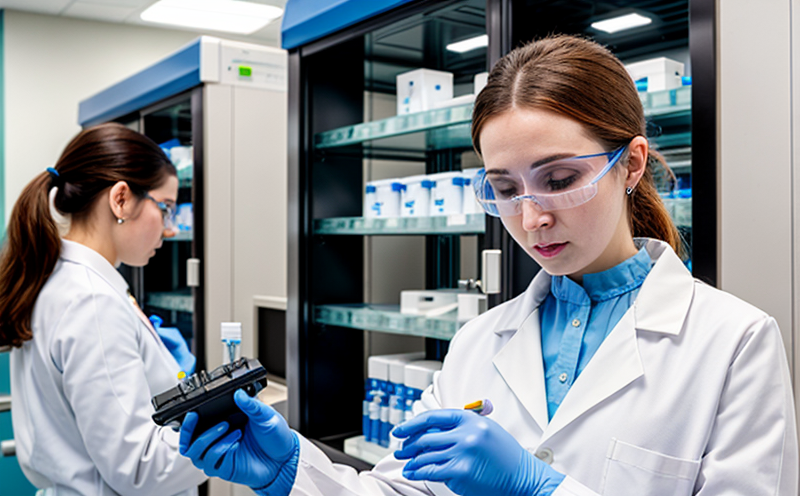Capillary Electrophoresis Bioanalysis Testing
Capillary electrophoresis (CE) bioanalysis testing is a sophisticated analytical technique that plays a pivotal role in the pharmaceutical sector. This method offers unparalleled sensitivity and resolution, making it an indispensable tool for drug development, quality assurance, and regulatory compliance.
The core principle of CE lies in its ability to separate charged species based on their electrophoretic mobility through a capillary-filled tube filled with buffer solution. The technique is highly versatile, capable of analyzing a wide range of biomolecules such as proteins, nucleic acids, peptides, and small organic molecules.
The pharmaceutical industry relies heavily on CE bioanalysis for several critical functions:
- Drug Discovery and Development: Identifying potential drug candidates by analyzing complex biological samples.
- Pharmacokinetics: Studying the absorption, distribution, metabolism, excretion, and toxicity of drugs in the body.
- Quality Control: Ensuring that manufactured batches meet specified purity standards.
- Regulatory Compliance: Meeting stringent requirements set by regulatory bodies like the FDA and EMA.
The technique's precision is particularly advantageous in bioanalytical studies where minute quantities of analytes are involved. CE can detect even trace amounts, making it crucial for ensuring drug safety and efficacy.
In summary, Capillary Electrophoresis Bioanalysis Testing serves as a cornerstone for the pharmaceutical industry, providing critical insights into drug development processes. Its high sensitivity, selectivity, and efficiency make it an essential tool in ensuring that only safe and effective drugs reach the market.
Scope and Methodology
The scope of Capillary Electrophoresis Bioanalysis Testing encompasses a broad range of applications within the pharmaceutical industry, focusing on the analysis of biomolecules. The methodology involves several key steps:
- Sample Preparation: Ensuring that the sample is suitable for analysis by CE.
- Injection: Introducing the sample into the capillary using a microliter loop or other injection methods.
- Electrophoresis: Applying an electric field across the capillary to separate the analytes based on their electrophoretic mobility.
- Detection: Monitoring the separation and identifying the components of the sample using a detector like UV-Vis or laser-induced fluorescence (LIF).
The methodology is governed by international standards, including ISO 17025 for laboratory accreditation and ICH Q3D(E9) for elemental impurities in pharmaceuticals. Compliance with these standards ensures that the results obtained are reliable and reproducible.
Instrumentation plays a crucial role in CE bioanalysis testing. The equipment typically includes a high-voltage power supply, temperature control systems, and detection devices. The choice of detector depends on the analyte being analyzed; for instance, UV-Vis is suitable for detecting nucleic acids, while LIF is preferred for peptides.
The acceptance criteria for CE bioanalysis testing are stringent to ensure that only high-quality results are reported. These include limits for detection sensitivity, resolution of peaks, and precision of quantification. The use of advanced software tools further enhances the accuracy and reliability of the analysis.
Industry Applications
The applications of Capillary Electrophoresis Bioanalysis Testing are extensive and varied across different areas within the pharmaceutical sector:
- New Drug Development: Identification and characterization of potential drug candidates.
- Pharmacokinetic Studies: Analysis of how drugs move through the body, including absorption, distribution, metabolism, excretion, and toxicity.
- Bioequivalence Testing: Ensuring that different formulations of a drug are equivalent in terms of bioavailability.
- Diagnostics: Development of diagnostic tools for early detection of diseases.
In drug development, CE is used to analyze complex samples, such as blood plasma or cell cultures, to identify biomarkers and potential therapeutic targets. Its ability to separate and quantify trace amounts of analytes makes it invaluable in these applications.
For pharmacokinetics, CE provides precise data on the concentration-time profiles of drugs, which is essential for understanding their behavior within the body. This information is critical for optimizing drug dosages and schedules.
Bioequivalence testing ensures that different formulations of a drug are equivalent in terms of bioavailability, allowing for the approval of generic drugs. CE plays a key role in this process by providing reliable data on the dissolution profiles of these formulations.
In diagnostics, CE is used to develop tools that can detect diseases at early stages, enabling timely intervention and treatment. This application highlights the importance of CE in advancing medical technologies.
Customer Impact and Satisfaction
- Precision: Ensures that only safe and effective drugs reach the market, enhancing patient safety. Efficiency: Reduces the time and cost associated with drug development by providing accurate data early in the process.
- Reliability: Builds trust between pharmaceutical companies and regulatory bodies through consistent results.
The use of CE bioanalysis testing has significantly impacted various stakeholders within the pharmaceutical industry, leading to enhanced product quality and improved patient outcomes. Regulatory authorities appreciate the reliability of CE data, which supports smoother approval processes for new drugs.
Pharmaceutical companies benefit from increased efficiency and reduced development costs, allowing them to bring more products to market faster. Additionally, healthcare providers gain access to safer and more effective treatments, ultimately improving patient care.





